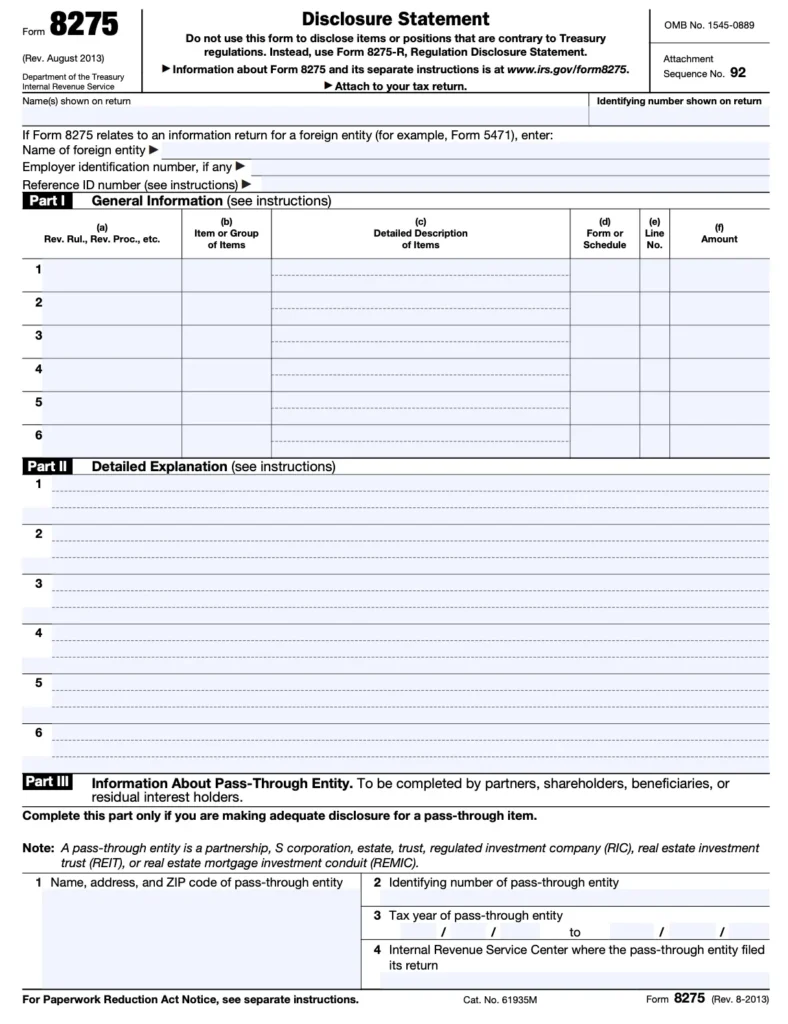IRS Form 8275, titled “Disclosure Statement,” allows taxpayers and tax professionals to disclose tax return positions that may not be adequately disclosed elsewhere on the return. This form protects against specific accuracy-related penalties by giving the IRS full transparency about your tax positions.
Filing Form 8275 is significant when:
- Claiming deductions or credits that might be questioned
- Taking positions contrary to IRS regulations
- Using interpretations of tax law that aren’t clearly supported
For complex tax situations, professional tax services can help determine if Form 8275 is necessary and ensure proper completion.
Table of Contents

Who Needs to File Form 8275?
You should consider filing Form 8275 if:
- You’re taking a tax position that lacks substantial authority
- Your return includes items that might trigger IRS scrutiny
- You want penalty protection for disclosed positions
- You’re a tax professional advising clients on controversial positions
Note: Form 8275 is voluntary but can provide valuable protection. Consult tax services if unsure whether your situation requires disclosure.
Step-by-Step Guide to Completing Form 8275
Step 1: Determine If Disclosure Is Needed
Review your tax positions and identify any that:
- Lack of apparent IRS approval
- Involve interpretation of complex regulations
- It might be considered aggressive by the IRS

Step 2: Gather Supporting Documentation
Collect all relevant:
- Legal authorities supporting your position
- Calculations and methodologies used
- Professional opinions or analyses
Step 3: Complete Part I – General Information
- Line 1a: Taxpayer name and SSN/EIN
- Line 1b: Tax year being disclosed
- Line 1c: Form or schedule number where an item appears
Step 4: Complete Part II – Detailed Disclosure
- Line 2: Describe the item or position in detail
- Line 3: Explain the legal basis for your position
- Line 4: Provide computations if applicable
Step 5: Complete Part III – Tax Practitioner Declaration
If prepared by a tax professional:
- Line 5a: Preparer’s name and PTIN
- Line 5b: Firm name and EIN
- Line 5c: Declaration signature
Step 6: Attach and File
- Attach Form 8275 to the front of your tax return
- Keep copies of all supporting documents
- File by your return’s due date (including extensions)
Common Mistakes to Avoid
- Vague descriptions: Be specific about positions and reasoning
- Missing deadlines: Must be filed with the original return
- Incomplete documentation: Maintain all supporting materials
- Over-disclosure: Only include positions that genuinely need protection
For proper disclosure strategy, consider professional tax services with experience in controversial positions.

Final Thoughts
Filing IRS Form 8275 provides essential protection when taking tax positions that might be questioned. By following these steps and providing complete, accurate disclosures, you can reduce penalty risks while maintaining compliance. For particularly complex situations, professional tax services can provide valuable guidance on what to disclose and how.










